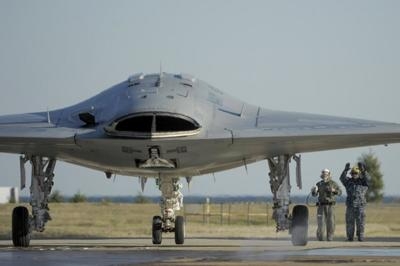Mon, Nov 19, 2012
Maneuvers With Handheld Controller Build Confidence For Future Trials On Carrier Deck
UAV carrier ops took another notch forward recently, as the U.S. Navy took the first critical step toward demonstrating that the X-47B Unmanned Combat Air System (UCAS) demonstrator can be maneuvered safely and wirelessly on the crowded deck of an aircraft carrier.

In early November, the team successfully completed its first shore-based trials of a new wireless, handheld device called a Control Display Unit (CDU). Developed by Northrop Grumman, the device will allow deck operators to maneuver the X-47B by remote control on the carrier deck. The team demonstrated the CDU's ability to control the X-47B's engine thrust; to roll the aircraft forward, brake and stop; to use its nose wheel steering to execute tight, precision turns; and to maneuver the aircraft efficiently into a catapult or out of the landing area following a mock carrier landing. Northrop Grumman is the Navy's prime contractor for the UCAS Carrier Demonstration (UCAS-D) program.
"The CDU is fundamental to integrating the X-47B seamlessly into carrier deck operations," said Daryl Martis, Northrop Grumman's UCAS-D test director. "It will allow us to move the aircraft quickly and precisely into the catapult for launch, or out of the landing area following recovery. Both of these activities are essential to maintaining the rhythm of the flight deck."
In practice, a deck operator will work in tandem with the flight deck director – aka a "yellow shirt" – to move the X-47B via the CDU to a designated flight deck location. Standing in front of the aircraft, the director will use traditional hand signals to indicate how, when and where the aircraft should move, the same way he would communicate with a pilot in a manned aircraft. The deck operator will stand behind the director and use the CDU to duplicate the director's instructions as digital commands to the aircraft. According to Martis, the CDU will help streamline and, in fact, enable many of the flight test operations required for UCAS-D shore-based carrier suitability testing. "Instead of towing the aircraft out to the flight line, we can now start the X-47B outside its hangar, then use the CDU to taxi it out to the runway, or into a catapult for launch," he said. "Use of the CDU is the most time-efficient way to move the X-47B into the catapult or disengage it from the arresting gear
after landing."
The UCAS-D program plans to conduct its first shore-based catapults of X-47B aircraft later this month. That testing will be followed by hoisting an X-47B aboard an aircraft carrier, and using it to validate the performance of the CDU in an actual carrier environment.
(U.S. Navy images)

More News
Terminal Radar Service Area Airspace surrounding designated airports wherein ATC provides radar vectoring, sequencing, and separation on a full-time basis for all IFR and participa>[...]
Aero Linx: Utah Back Country Pilots Association (UBCP) Through the sharing experiences, the UBCP has built upon a foundation of safe operating practices in some of the most challen>[...]
From 2010 (YouTube Edition): Imagine... Be The Change... Inspire FROM 2010: One of the more unusual phone calls I have ever received occurred a few years ago... from Anousheh Ansar>[...]
(Pilot) Felt A Shudder And Heard The Engine Sounding Differently, Followed By The Engine Chip Detector Light On April 14, 2025, about 1800 Pacific daylight time, a Bell 206B, N1667>[...]
Also: AMA Names Tyler Dobbs, More Falcon 9 Ops, Firefly Launch Unsuccessful, Autonomous F-16s The Air Force has begun ground testing a future uncrewed jet design in a milestone tow>[...]
 ANN's Daily Aero-Term (05.07.25): Terminal Radar Service Area
ANN's Daily Aero-Term (05.07.25): Terminal Radar Service Area ANN's Daily Aero-Linx (05.07.25)
ANN's Daily Aero-Linx (05.07.25) Classic Aero-TV: Anousheh Ansari -- The Woman Behind The Prize
Classic Aero-TV: Anousheh Ansari -- The Woman Behind The Prize NTSB Prelim: Bell 206B
NTSB Prelim: Bell 206B Airborne-NextGen 05.06.25: AF Uncrewed Fighters, Drones v Planes, Joby Crew Test
Airborne-NextGen 05.06.25: AF Uncrewed Fighters, Drones v Planes, Joby Crew Test




